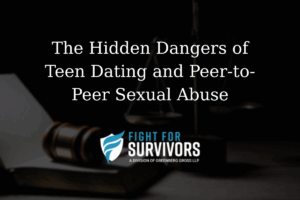
In the complex and emotionally charged world of adolescence, dating can be both exciting and perilous. For many teens, relationships are their first experience with romantic connection, but far too often, they’re also their first encounter with abuse. Peer-to-peer sexual abuse and teen dating violence are deeply underrecognized forms of interpersonal harm—occurring at alarming rates and with serious, long-term consequences. Yet the silence around these issues leaves many young people suffering alone, unsure of how to recognize warning signs or seek help.
This article aims to unpack the hidden dangers within teen dating, including the varied forms of dating abuse, the psychological and physical impacts on young survivors, and what parents, schools, and communities can do to protect adolescents navigating early relationships.

The Reality of Teen Dating Violence
Contact Us For A Free Legal Consultation. No Fee.
Call (833) 55-FIGHTTeen dating violence includes a range of abusive behaviors between two people in a dating relationship, whether casual, exclusive, or even undefined. It can involve emotional manipulation, physical aggression, controlling behaviors, and sexual abuse. Many teens experience dating violence without even realizing it. Abuse may be disguised as jealousy, “possessiveness,” or “just caring too much”—especially when early relationship models have normalized aggressive behavior.
Research shows that one in three high school students has experienced some form of physical, emotional, or sexual violence from a dating partner. These harmful patterns often begin early. In fact, many girls report dating abuse for the first time between the ages of 11 and 14. Despite this, very few adolescents report abuse or seek help from trusted adults.
What Counts as Teen Dating Abuse?
Teen dating abuse goes far beyond visible bruises. It can take several forms:
- Physical dating violence: Includes hitting, slapping, shoving, or physically restraining a partner.
- Sexual violence: Coercing, pressuring, or forcing a partner into any sexual activity, including digital sexual coercion or non-consensual sharing of intimate text messages.
- Emotional abuse: Name-calling, guilt-tripping, humiliation, or gaslighting.
- Psychological abuse: Isolation from peers and family, intimidation, and threats.
- Digital abuse: Monitoring someone’s social media or phone, demanding passwords, or threatening to share private photos.
In teen dating, these abuses may be reinforced by social dynamics at school or online. Many adolescents don’t yet have the tools to identify healthy relationship behaviors, leaving them vulnerable to mistaking control for care, or abuse for attention.
Sexual Abuse in Peer Relationships
Sexual abuse among adolescents is particularly insidious because it often occurs between peers who know and trust one another. This can involve a dating partner, classmate, or even a friend. When abuse occurs in familiar contexts—like at school, parties, or during unsupervised hangouts—it is less likely to be recognized or reported.
Peer-to-peer sexual abuse may include:
- Non-consensual touching or groping
- Sexual coercion or manipulation
- Rape or attempted rape
- Unwanted sexual text messages or pressure to send nudes
- Forced sexual acts while under the influence of drugs or alcohol
Because many adolescents are still learning about sexual health, consent, and boundaries, they may struggle to even identify what’s happening to them as abuse. This confusion is compounded by shame, peer pressure, and a lack of comprehensive education around consent and respectful behavior.
Warning Signs of Dating Abuse in Teens
Recognizing abuse is the first step in interrupting it. For teens, abuse may not always be obvious—especially if it doesn’t involve physical violence. Parents, educators, and peers should watch for the following warning signs:
- Withdrawal from friends, school, or family activities
- Dramatic changes in mood, behavior, or appearance
- Unexplained bruises or injuries
- Constant texting with a partner and fear of making them angry
- Drop in academic achievement or school attendance
- Sudden depression, eating disorders, or suicidal thoughts
- Excessive concern about being “liked” or “approved of” by a partner
It’s also important to note that boys, LGBTQ+ teens, and college students also experience abuse—though they are often less likely to report it due to stigma around masculinity, sexual orientation, or victim-blaming.
Risk Factors and Protective Factors
There are well-documented risk factors that increase the likelihood of dating violence among teens. These include:
- Early exposure to family violence or child abuse
- Aggressive behavior or conduct disorder
- Poor emotion regulation or impulse control
- Community violence and youth violence
- Peers who normalize or encourage controlling behavior
- Substance use or abuse
On the flip side, protective factors can reduce the risk of abuse or help adolescents recover more quickly. These include:
- Strong, supportive relationships with trusted adults
- Comprehensive education around healthy relationships and consent
- High academic achievement
- Emotion regulation skills and mental health support
- Positive peer influence
- Clear boundaries and respect in the family structure
Empowering teens with the tools to build healthy relationships can prevent abuse before it starts.
The Long-Term Impact of Dating Violence
Survivors of teen dating violence and sexual abuse often carry the effects with them for years. The trauma can manifest in various forms, including:
- Depression and anxiety
- PTSD and intrusive thoughts
- Low self-esteem and trust issues
- Suicidal ideation or suicide attempts
- Disordered eating
- Difficulty forming future relationships
Teens who experience abuse are also more likely to face poor academic performance and higher rates of substance use. When abuse goes unaddressed, it sets a precedent for violence in adult relationships, perpetuating cycles of harm and disempowerment.
The Role of Schools and Communities
Schools are a critical frontline in the fight against teen dating violence. They can either help identify abuse and intervene—or contribute to the silence that keeps it hidden. Schools must:
- Train educators to recognize signs of dating abuse
- Implement sexual education that includes discussions of consent and respect
- Provide access to counselors or mental health professionals
- Establish clear reporting systems for abuse
- Support victims without blaming or stigmatizing them
At the community level, organizations should engage youth in conversations about dating abuse, emotional regulation, and boundaries. Involving parents and families in education is essential, but so is acknowledging that not all homes are safe. That’s why safe spaces outside the home—like school clubs, mentoring programs, and youth groups—are crucial protective factors.
How Parents Can Help
Parents play a critical role in helping teens navigate dating relationships and identifying abuse. Open, judgment-free communication is essential. Encourage conversations about:
- What makes a relationship respectful and safe
- Why it’s okay to set boundaries and say no
- How to respond if a friend experiences abuse
- What to do if they feel unsafe or controlled in a relationship
Avoid fear-based or punitive responses. Instead, offer support, validation, and access to resources. When parents model respect and empathy, teens are more likely to mirror those behaviors in their relationships.

Prevention Is Possible
Preventing teen dating abuse starts with education and intervention. That includes teaching children early about bodily autonomy, practicing respect in everyday interactions, and exposing young people to examples of healthy relationship behaviors.
Prevention also means addressing the broader culture that tolerates or excuses violence. Media, peer pressure, and traditional gender norms often glamorize control, jealousy, and dominance in relationships. Countering these harmful messages is part of building a safer world for all youth.
You Are Not Alone
If you or someone you know is experiencing teen dating abuse, you are not alone—and you are not to blame. No matter your age, background, or relationship, everyone deserves love that is rooted in safety, consent, and mutual respect.
Reach out to a counselor, teacher, or trusted adult. Help is available. There are organizations and helplines ready to support you with resources, advocacy, and understanding.
Frequently Asked Questions
What is considered teen dating violence?
Teen dating violence includes physical, emotional, or sexual abuse by a partner in a dating relationship. It can involve controlling behaviors, manipulation, threats, or physical harm.
Are certain teens more at risk for abuse?
Yes. Teens exposed to child abuse, community violence, or family violence are at higher risk. LGBTQ+ youth and teens with mental health challenges may also face increased vulnerability.
What are signs a teen may be in an abusive relationship?
Signs include sudden isolation, changes in behavior, excessive texting with a partner, declining school performance, and emotional distress.
Is sexual abuse common in teen relationships?
Unfortunately, yes. Many teens experience sexual coercion or assault from dating partners or peers. These incidents are often underreported due to shame or confusion.
How can I help a teen who may be experiencing abuse?
Listen without judgment, validate their feelings, and connect them to resources. Avoid blaming or minimizing their experience. Encourage them to speak with a school counselor or therapist.
Experienced Attorneys Who Will Listen And Fight For You
Speak To An Attorney Now »